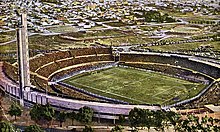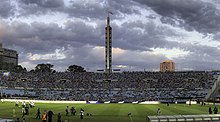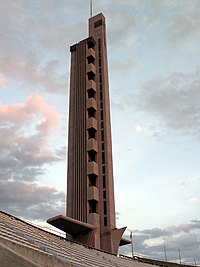Centennial Stadium
The Centenario Stadium is a football stadium that is among those that hosted the World Cup. It is located in the Parque Batlle neighborhood of Montevideo, Uruguay. It is administered by the Official Field Administrative Commission (CAFO), made up of three members from the Uruguayan Football Association and two from the Municipality of Montevideo. It is the stadium with the largest capacity in Uruguay and one of the fifteen largest in America. On July 18, 1983 it was declared by FIFA as a Historical Monument of World Football, being the only construction of this kind throughout the world.
It hosted, among other tournaments, the 1930 Soccer World Cup, the 1942 South American Championship, the 1956 South American Championship, the 1967 South American Championship, the World Champions Gold Cup in 1980 and the 1995 Copa América, all won by Uruguay. Currently, the Uruguayan soccer team plays its home games in this stadium. Any Uruguayan club that requests to play its matches in this setting can do so by renting it. It is the stadium with the largest number of matches played on its field in the history of the Copa Libertadores de América.
Its current capacity is 60,235 people. Its highest capacity was 74,860 spectators, once the two headers were expanded. With the expansion of the main stand, the capacity would have been 90,000 people, but this did not happen, and the official stand is smaller than the others. With the closure of the slopes for safety reasons, the capacity was reduced, reaching the current numbers.
In addition to being the largest stadium in the country, it is the Uruguayan stadium with the best artificial lighting along with the Gran Parque Central Stadium, with lighting of 1,500 lux, after a renovation carried out in 2021.
Locality
Since its inauguration in 1930 for the World Cup that year, the Centenario stadium has been used by the Uruguayan national football team in home matches, in addition to the Uruguayan teams that request to do the same. Peñarol used it as a stage of most of its home games, until April 9, 2016, the day in which it inaugurated the Campeón del Siglo stadium. Nacional finally decided to play Copa Libertadores matches there, in addition to classics and some other occasions for the Uruguayan championship. Additionally, many first division teams choose to use the stadium as a venue for their matches against Nacional and Peñarol, or matches for international Conmebol competitions, being the stadium on the continent with the most Copa Libertadores de América matches played..
History
Construction


El Centenario is one of the most important stadiums in the sports development of South America and international football. It was built especially for the organization of the 1930 Soccer World Cup, by immigrant workers in a record time of 9 months. Its name originates from the celebration of the 100 years of the swearing in of the first Constitution of Uruguay.
Initially, all the World Cup matches would be held in the Centennial. However, the heavy rains that hit Montevideo some time before prevented the completion of the construction of the stadium, so several matches had to be held in Parque Central, belonging to the National Football Club, and the now defunct Pocitos Stadium, of the Club Atlético Peñarol.
Sports events
The Centenary was inaugurated on July 18, 1930, in the match between Uruguay and Peru, with the celeste team winning 1-0, with a goal from Héctor "Manco&# 3. 4; Castro. The final of said World Cup pitted the Uruguayan National Team against Argentina, with Uruguay winning 4-2. For the Copa América, the 1942 and 1956 editions were played entirely in the Centenario, the 1967 final phase, and some matches, including the final, of the 1995 edition. On all four occasions the winner was Uruguay, making it the only team that has become champion of the tournament in this stadium.
The first match of the Intercontinental Cup was played, in the 1960 edition, between the European champion Real Madrid and the South American champion Peñarol. Furthermore, Peñarol itself achieved the first intercontinental championship for South America in 1961, beating Benfica.
The third and final final of the 1967 Intercontinental Cup was also played here between Racing Club and Celtic Football Club, winners of the 1967 Copa Libertadores and the 1966-67 European Champions Cup, respectively. The Argentine team was proclaimed champion, being the first time that a team from that country managed to win this competition.
Fourteen final matches of the Copa Libertadores de América have been played at the Centenario Stadium. The only clubs that have become champions of this tournament in the Centennial are Nacional in 1980 and 1988, Estudiantes de la Plata in 1970, Independiente in 1973, Flamengo in 1981, Boca Juniors in 1977 and Palmeiras. in 2021
It also hosted the entire 1980 Mundialito, and along with other stadiums in Uruguay, two U-20 South American Championships (1979, 2003), and a U-17 South American Championship (1999).
Sectors


The stadium has four sectors, separated by access stairs to the lower locations (stalls and slopes). In the western lateral sector the Tribuna América is located. In its central section is the Official Box, with space for 1,882 additional people, including the individual closed VIP boxes and the press sector at the top. For its part, the rest of the grandstand open to the general public has capacity for 5,957 spectators distributed in two rings (trays). Finally, in the lower area of the sector is the Platea América, with space for 2,911 spectators. All this totals a maximum capacity for the sector of 10,750 seated people.
In the eastern side sector is the Olympic Grandstand and the lower stalls of the same name. Its name derives from the fact that by the date of the stadium's construction the Uruguayan team had recently won two consecutive Olympic championships (1924 and 1928). The Olympic Grandstand has a capacity of 18,907 spectators in its three rings, while the Olympic Plaza has 2,741 additional seats, totaling a capacity for the sector of 21,648 seated spectators. At the bottom of the Olympic Grandstand is the Uruguayan Football Museum.
At the head of the stadium are the popular sectors, so called because their seats are generally the cheapest. In the northern sector is the Colombes Tribune, named in honor of the French town where the stadium where the Uruguayan team won the Olympic gold medal in 1924 is located. The southern sector is the Amsterdam Grandstand, so named because it was in that city where the celestes were crowned Olympic champions for the second consecutive time in 1928. The Grandstand Colombes has capacity for 13,914 spectators while the Amsterdam Grandstand can accommodate 13,923 people. Both sectors, practically symmetrical to each other, also have a lower slope with space for approximately 2,500 additional spectators in each one, which are generally not enabled after the stands were removed at the end of the XX century by security reasons.
Tower of Tributes

One of the most distinctive and original architectural elements of the Centenario stadium is, without a doubt, the Tower of Tributes which stands out above all the infrastructure like a kind of needle. It has the function of being a viewpoint into the interior of the stadium and towards the city.
It consists of an independent reinforced concrete building, inserted in the middle of the Olympic tribune (south) and has a height of 100 meters. It was declared Historical Heritage of Montevideo.
The architect Juan Scasso was inspired by a similar tower that he observed in a stadium in the Netherlands, with the difference that he chose to design it with national symbolism that justifies its name: each of the nine balconies of the viewpoint represents the stripes of the flag of Uruguay (five white and four blue), while the base of the tower imitates the wings of an airplane and the bow of a ship, in reference to the arrival of immigrants to the country. The tower is crowned by a flagpole on which a large Uruguayan flag flies regularly.
Other facilities
Inside the Centenario stadium, there are other facilities. For example, there is the Uruguayan Football Museum, also known as Football Museum, which highlights sporting achievements of the national team or Uruguayan football. It is located below the Olympic tribune of the Centenario stadium and was inaugurated on December 15, 1975. In 2004 it underwent a remodeling, in which a panoramic elevator was added to the Tower of Tributes.
The Museum has a large collection of objects reminiscent of the most outstanding moments of Uruguayan and world football. This is administered by the Administrative Commission of the Official Field (CAFO), which is made up of representatives of the AUF and the Municipal Administration of Montevideo. On July 21, 1929, the founding stone of the Stadium was laid, which is located under the tower and can also be visited.
There is also a school operating under the Olympic grandstand.
Sports events that hosted the largest audience
- Source: 100 years history of Uruguayan football
Concerts
The Centenario Stadium has received numerous and massive concerts, both by national and international artists. Some of the artists who have given their shows at this stadium are:
| Artist | Year |
|---|---|
| Alfredo Zitarrosa, Víctor Heredia, Psiglo, Vera Sienra, Sindykato, Quilapayún, Dean Reed | 1973 |
| July Churches | 1983 |
| Alfredo Zitarrosa, Los Olimareños, Joan Manuel Serrat, Alfredo Zitarrosa, Daniel Viglietti, Numa Moraes, Yamandu Palacios, Lack and rest, Chico Buarque | 1984 |
| Mercedes Sosa | 1985 |
| Joan Manuel Serrat | 1986 |
| Joan Manuel Serrat | 1988 |
| Rod Stewart | 1989 |
| Mick Taylor, Eric Clapton, Sting | 1990 |
| Paul Simon, The Cult | 1991 |
| Roxette, Joe Cocker, Brian May, The B-52's, Serú Girán, Ricardo Montaner | 1992 |
| Fito Páez, Ricky Martin | 1993 |
| Plácido Domingo, Luciano Pavarotti, Luis Miguel, Joan Manuel Serrat | 1996 |
| Nickel, Maná, Soledad Pastorutti | 1998 |
| Enrique Iglesias, Fito Páez, Luis Miguel | 1999 |
| You don't like it. | 2000 |
| Alejandro Sanz, Patricio Rey and his Redonditos de Ricota | 2001 |
| vultures After the One | 2003 |
| Nortec Collective, No Te Va Gustar, Jorge Drexler, Joe Vasconcellos, Tree, Amaral, Arnaldo Antunes | 2006 |
| Bryan Adams, Chayanne, Joan Manuel Serrat, Joaquín Sabina | 2007 |
| Teen Angels | 2008 |
| The Olimareños | 2009 |
| Ricardo Arjona, ReyToro, Sebastian Bach, Guns N' Roses | 2010 |
| Mana | 2011 |
| Silvio Rodríguez, Paul McCartney, Marc Anthony, Chayanne | 2012 |
| Snake, Aerosmith, Marc Anthony | 2013 |
| One Direction, Paul McCartney, Rod Stewart | 2014 |
| Boomerang, The Rolling Stones, Maná, Marc Anthony | 2016 |
| I am Luna, Ricardo Arjona, Joaquín Sabina | 2017 |
| The Pretenders, Phil Collins, Roger Waters | 2018 |
| Ed Sheeran | 2019 |
| Maroon 5 | 2020 |
| No Te va Gustar, Jaime Roos | 2021 |
| La Vela Puerca,, Guns 'N Roses, Tini | 2022 |
Sports events
Contenido relacionado
Annex:Athletics at the 2004 Athens Olympics – Men's hammer throw
Berlin New Guard Building
Broom of 15


